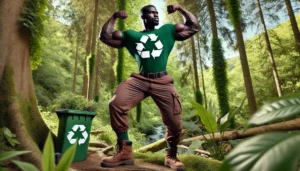Circular Economy vs Linear Economy: when we size up these economic models, like prize fighters about to step into the ring, only one true champ emerges.
Let’s break it down.
Circular Economy vs Linear Economy

CIRCULAR ECONOMY VS LINEAR ECONOMY
In one corner we have the traditional Linear Economy, an outdated, rather pudgy model which has dominated since the industrial age. Characterized by its ‘take, make, waste’ approach, it operates on a straightforward but woefully shortsighted principle: take resources, make products, use them, and then toss them away like yesterday’s kicks. And while it’s powered a frightening industrial and economic growth over the last century, the Linear Economy’s flaws are becoming more and more glaring and evident.
In the other corner we have the Circular Economy, lean, efficient and designed for sustainability. Unlike its chubby linear opponent, the Circular Economy is founded on the principles of reducing waste, reusing materials, and recycling products to extend their life cycle. Redefining the future, it’s an innovative model focusing on positive society-wide benefits and — go figure — wisely using our planet’s resources.
A Quick History of Economic Models: From Linear to Circular

SCHOOL’S IN SESSION
As mentioned, the Linear Economy came about during the Industrial Revolution of the 18th and 19th centuries. Marked by mass production and rapid technological innovations, it was a period of unprecedented growth, fueled by an abundant supply of natural resources and an insatiable demand for products. Under these conditions the linear model prospered, driving national economies and raising the living standards worldwide.
Unfortunately, it misfired in one important regard: it was a system which overlooked the environmental impact of unchecked consumption and waste.
Now, to parry and pivot, the concept of the Circular Economy started gaining traction in the late 20th and continues to do so presently, as a response to the environmental and resource challenges posed by the linear model. Influenced by ecological economics and industrial ecology, along with the pioneering work of Walter R. Stahel and Genevieve Reday-Mulvey, the Circular Economy model promotes sustainability through resource efficiency, waste reduction, and prolonged material use.
Why the Circular Economy is the Better Option for the Environment

GYM GAINS, ENVIRONMENTAL GAIN, CIRCULAR ECONOMY GAINS
There are gym gains, and there are environmental gains, and with the Circular Economy the latter are substantial. Let’s explore some of the reasons:
Reduced Resource Extraction
The Circular Economy reduces the need for new raw materials by advocating the reuse, repair, refurbishment and recycling of existing products. Consequently, the environmental impact tied to resource extraction (i.e. habitat destruction, water pollution, soil erosion, etc.) are reduced.
Lower Greenhouse Gas Emissions
Without doubt, by extending the lifespan of products and reducing the need for new manufacturing, the Circular Economy can substantially decrease greenhouse gas emissions. Manufacturing processes are often energy-heavy and reliant on fossil fuels, so cutting down production frequency helps lower carbon emissions.
Waste Reduction
Seeking to eliminate waste by keeping products and materials in circulation for as long as possible is the goal of the Circular Economy — contrasting significantly with the linear model’s ‘throwaway’ culture which contributes to increasing landfills and pollution.
Improved Biodiversity
Lower resource extraction and waste generation lead to less environmental degradation, protecting ecosystems and biodiversity. This is important for many reasons, but perhaps most importantly for preserving the balance of our planet’s natural resources.
Economic Stability
The Circular Economy can also deliver economic benefits by creating new business opportunities and jobs in recycling and remanufacturing sectors. It encourages companies to create more sustainable products and services and stimulates innovation.
eAsset Solutions: Keeping it Circular with Electronics Recycling
At eAsset Solutions, our dedication to realizing the principles of the Circular Economy in electronics recycling is second to none. Everything appears to be moving at breakneck speed, technologically-speaking, and the surge of e-waste presents considerable environmental and health hazards if not properly managed. Our strategy aims to tackle this issue head on by keeping functional devices in use and reducing the need for new manufacturing.
Extending Product Lifespans
We concentrate on extending the lifespan of electronics through various methods:
Reuse
Functional devices that are no longer needed can often be repurposed and resold, not only keeping these products out of landfills but also making technology more accessible to those who might not otherwise be able to afford new devices.
Component Harvesting
When devices are no longer functional, their components can often still be harvested and reused in other products. Keeping these respective parts in circulation reduces the need for new materials and minimizes waste.
Certified Data Destruction
Protecting data security is critical when repurposing, reusing or recycling electronic devices, and our certified data destruction services guarantee that all data is completely removed on any and all media-bearing devices, allowing for the safe reuse and recycling of electronics.
Advocating for Eco-Friendly Practices
At eAsset Solutions, we believe in leading by example. I mean, who doesn’t? If you talk the talk, you must walk the walk, and we’ve been strutting our stuff for nearly twenty years. We design our operations to alleviate the environmental impact, and we tirelessly advocate for eco-friendly practices within our industry and community. This involves:
Eco-Friendly Disposal
When devices truly reach the end of their life, we make certain they are disposed of in an eco-friendly manner, including the proper recycling of hazardous materials and components.
Education and Advocacy
Through social media outreach, blogs, conferences, hosting recycling events and partnerships, we continually educate our community and clients about the benefits of the Circular Economy and the importance of sustainable electronics management. Our aim is to raise awareness and promote positive change, as well as support sustainable lifestyles like beekeeping.
eAsset Solutions: Thinking Outside the Box

THINKING OUTSIDE THE BOX
Thinking outside the box is at the heart of our approach. We continuously seek new ways to improve our processes and develop more sustainable solutions for electronics recycling. In addition to our regulatory audits to maintain R2v3 and RIOS currency we:
Invest in state-of-the-art data destruction technologies such as our LM-1 Degausser, which increases efficiency of data destruction and reduces the environmental impact which can occur when shredding hard drives.
Collaborate and partner with other organizations, such as WUSA Channel 9 and universities, as well as local schools, to help advance the Circular Economy. By working together, we can develop comprehensive solutions that address the complex challenges of e-waste.
Final Thoughts
So in the final showdown between the Circular Economy vs Linear Economy it’s pretty clear who emerges victorious as the champion. And eAsset Solutions has been in the champ’s corner from the beginning, offering a sustainable alternative that addresses the environmental and economic shortcomings of the old, dated and traditional linear model.
We dedicate ourselves to promoting the Circular Economy through our innovative approaches to electronics recycling, and by keeping functional devices in circulation, we contribute to a more resilient, environmentally friendly and greener future. See how you can help in promoting a more sustainable future by reaching out to us or contacting us here.






